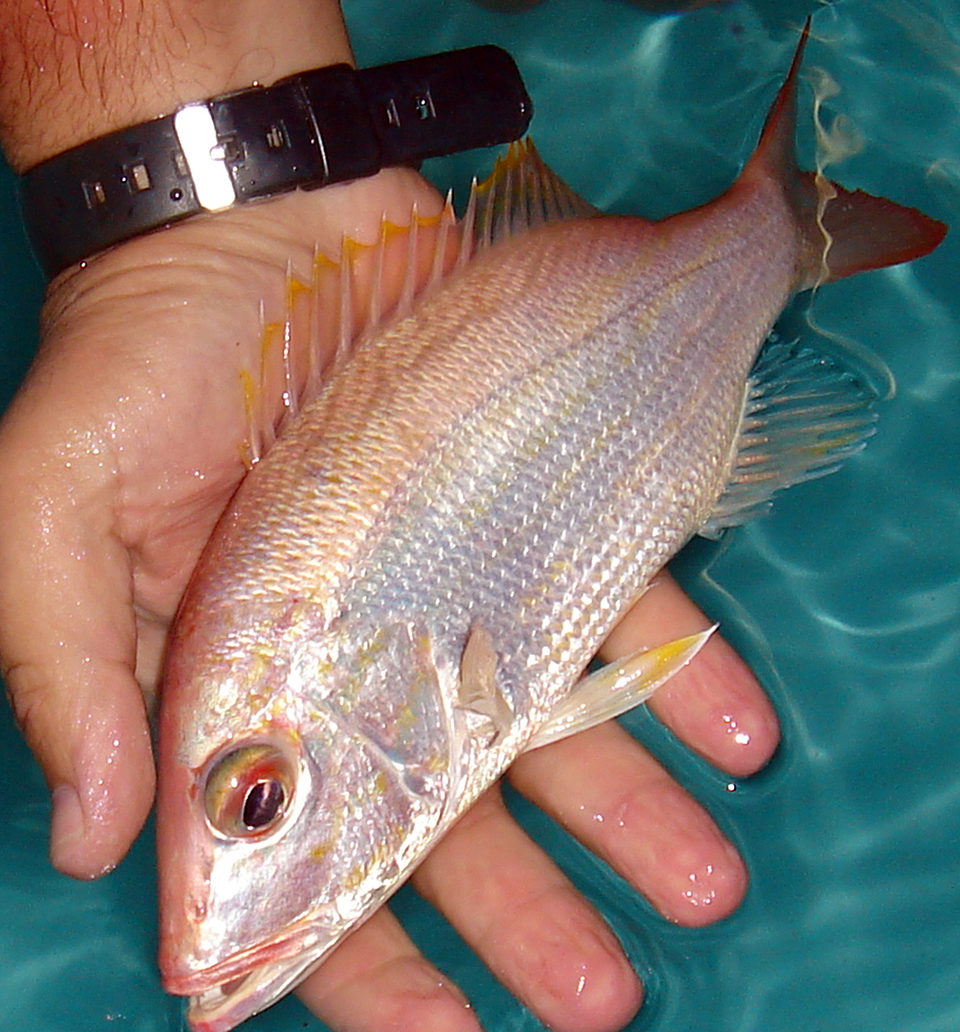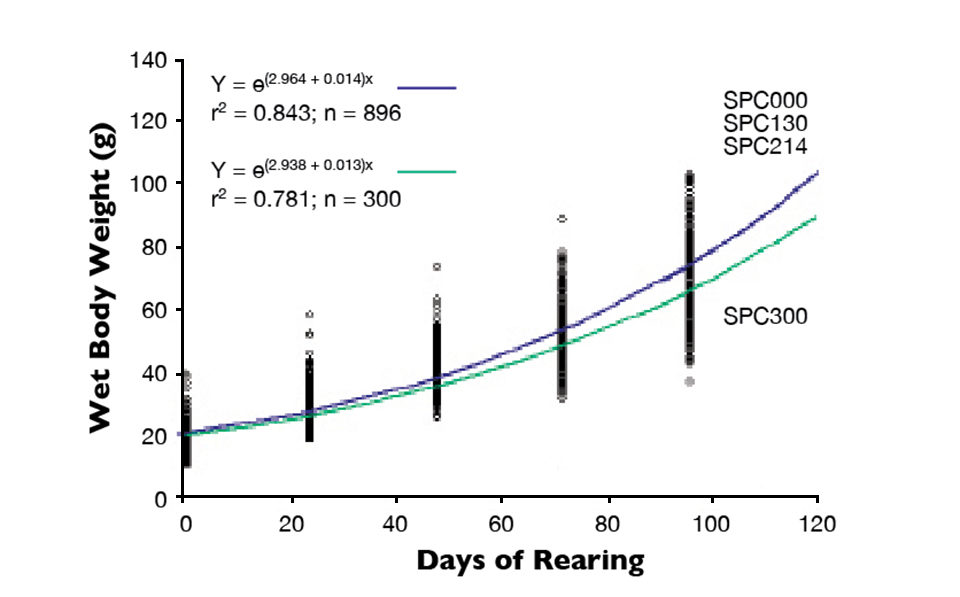Higher levels of whole squid meal aids palatability

Although techniques for spawning in captivity have been achieved for several species, aquaculture of high-value snappers is still poorly developed. The mutton snapper (Lutjanus analis) is among several lutjanids with potential for commercial aquaculture. The species easily adapts to confinement, readily accepts artificial food and tolerates frequent handling.
Fishmeal substitution
Past work has shown the species is predominantly carnivorous, requiring diets with a minimum of 44 percent crude protein and between 6 and 9 percent lipids. Most feeds designed for snapper growout contain levels of fishmeal above 30 percent. As supplies of fishmeal are not forecasted to increase, expansion of marine aquaculture may be restrained if the ability of finfish to use alternative protein sources is not fully explored.
Soy protein concentrate (SPC) is currently one of the most investigated alternative protein ingredients for aquafeed. SPC has a crude protein content over 60 percent and lower levels of anti-nutritional factors than those found in ordinary defatted soybean meal. Studies carried out with SPC have shown its protein digestibility for marine fish species is comparable to that of fishmeal.
Snapper study
Recent research by the authors investigated the growth of mutton snappers fed diets with increasing replacement levels of fishmeal by SPC. Wild juvenile snappers of 12.7 grams body weight were initially acclimated to laboratory rearing conditions on fresh food made from a mixture of ground shrimp and fish. Next, the animals were slowly weaned to feed on experimental diets.
Four experimental diets with similar crude protein (45 percent), lipid (10 percent) and energy levels (18 kJ/g) were manufactured with substitution of anchovy fishmeal by a commercial soy protein concentrate. The control diet, SPC000, had 36.0 percent fishmeal and no SPC. Diet SPC130 contained 26.9 percent fishmeal and 13.0 percent SPC, while SPC214 had 16.0 percent fishmeal and 21.4 percent SPC. The SPC300 diet was made with 9.0 percent fishmeal and 30.0 percent SPC.
The diets with higher inputs of SPC were supplemented with D.L.-methionine and L-lysine in order to keep essential amino acid levels balanced between 1.97 and 2.18 percent, and 3.65 and 4.02 percent of diet, respectively. Whole squid meal was also added to the experimental diets as SPC inclusion rose, from 1.0 percent in SPC000, to 1.5, 2.0 and 2.5 percent in diets SPC130, SPC214 and SPC300, respectively.
When the fish reached a body weight of about 18.5 g, they were stocked at 15 animals per cubic meter in an outdoor recirculation system. Sixteen circular 1,000-liter tanks were used to allow four replicate tanks per treatment. Animals were fed three times daily and reared for 95 days.
Results
Over the culture period, water temperature (30.78 ± 1.09 degrees-C), dissolved oxygen (5.73 ± 0.22 mg/L) and pH (7.67 ± 0.31) were kept within normal ranges for fish culture. The growth performance of the mutton snappers was related to fishmeal substitution level.
At harvest, fish fed diet SPC300 attained 54.9 ± 13.2 grams mean body weight – significantly lower than the 76.5 ± 14.0 grams, 73.9 ± 13.8 g and 70.5 ± 14.0 grams achieved with fish fed diets SPC000, SPC130 and SPC214, respectively (P < 0.05). Similarly, fish yield dropped significantly, from an average of 1,099 ± 111 g/m3 for SPC000, SPC130 and SPC214 to 891 ± 36 under treatment SPC300. Fish survival was high for all treatments. Only one loss was observed among the 240 farmed fish.
Maximum daily body weight gain for the snappers fed diet SPC000 was 0.60 ± 0.05 grams, while maximum specific growth rate reached 1.47 ± 0.07 percent/day. By extrapolating the growth data, it was found that the mutton snappers would reach 1 kg in 282 days when fed diets SPC000, SPC130 or SPC214, but 24 additional days of rearing would be required when fed SPC300 (Fig. 1).

Apparent feed intake (AFI) decreased as replacement of fishmeal with soy protein concentrate increased in diets. Statistical differences in AFI were observed when diet SPC300 was compared to diets SPC000 and SPC130 (P < 0.05). However, mutton snappers fed more on diet SPC000 than the others, as AFI values were 6, 15 and 33 percent higher for SPC000 in relation to SPC130, SPC214 and SPC300, respectively. At 1.85 ± 0.06, there was no significant statistical difference for feed-conversion ratio among the different diets (P > 0.05).
Perspectives
In this study, the loss of growth performance of mutton snappers fed higher inclusion levels of soy protein concentrate was related to poor feed palatability. The inclusion of whole squid meal in SPC300 was not sufficient to achieve feed intake as high as that observed for the fishmeal control diet. Therefore, it is advisable to adopt higher levels of whole squid meal when inclusion of fishmeal falls below 10 percent in diets for mutton snappers.
Despite the loss of performance at high fishmeal replacement levels, the work indicated that mutton snappers can grow well on diets containing high levels of high-quality plant protein sources such as soy protein concentrate. Further work should focus on feed ingredients that can counteract the palatability issues of plant-based diets.
(Editor’s Note: This article was originally published in the March/April 2010 print edition of the Global Aquaculture Advocate.)
Authors
-
Alberto J.P. Nunes, Ph.D.
LABOMAR – Instituto de Ciências do Mar
Fortaleza, Ceará, Brazil[114,98,46,109,111,99,46,108,111,117,64,110,112,106,111,116,114,101,98,108,97]
-
Luiz E.L. Freitas, M.S.
LABOMAR – Instituto de Ciências do Mar
Fortaleza, Ceará, Brazil -
Marcelo V.C. Sá, Ph.D.
LABOMAR – Instituto de Ciências do Mar
Fortaleza, Ceará, Brazil
Tagged With
Related Posts

Health & Welfare
Advances in intensive copepod production technology
Research at the Oceanic Institute has been successful in overcoming bottlenecks associated with rearing small-mouthed fish larvae by finding a suitable first feed. Early work on the calanoid copepod Parvocalanus crassirostris focused on parameters necessary for successful maintenance of stock cultures.

Intelligence
Aquaculture key to increasing seafood supplies to Arab states
Arab States have substantial natural resources to increase aquaculture production. Several types of systems are readily adaptable and can be implemented relatively quickly.

Responsibility
Assessing culture potential of red emperor snapper in New Caledonia
The red emperor snapper, known as “pouatte” in New Caledonia, is valuable throughout its broad geographic range and a highly valued food fish locally. Declining wild catches and market demand have provided the incentive to carry out technical feasibility studies to determine its commercial aquaculture potential.

Intelligence
Bahamas venture focuses on grouper, other high-value marine fish
A new venture under development in the Bahamas will capitalize on Tropic Seafood’s established logistics and infrastructure to diversify its operations from processing and selling wild fisheries products to include the culture of grouper and other marine fish.


